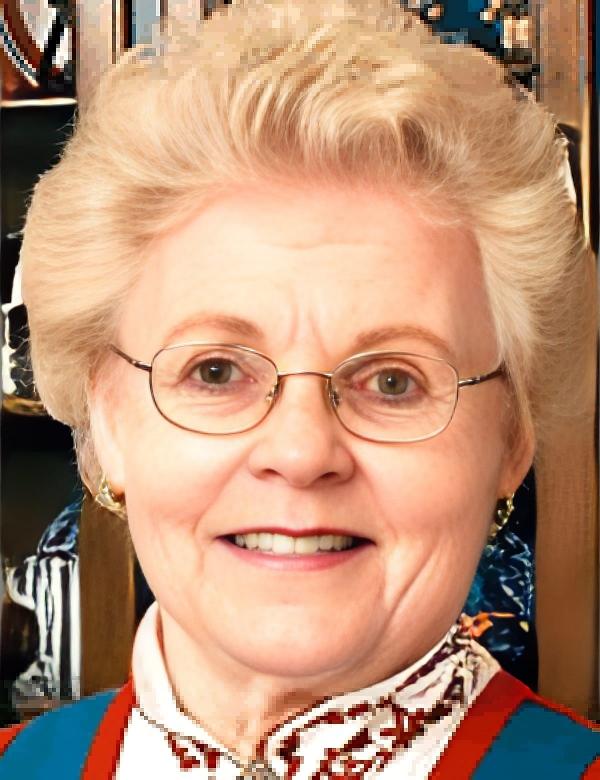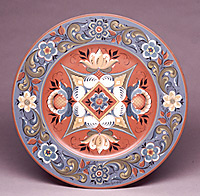Eldrid Skjold Arntzen

Photo by Tom Pich
Bio
The Vesterheim Norwegian-American Museum in Decorah, Iowa, awarded Eldrid Skjold Arntzen the Gold Medal for rosemaling (literally rose or "to decorate" and maling or "to paint" in Old Norwegian) in 1987, the highest form of recognition for this art form in the U.S. Rosemaling flourished in 16th and 17th-century Norway as a form of decoration on wood and was used on utilitarian objects and furnishings in rural churches and homes. Many practitioners were local craftsmen, without land, who became itinerant painters, accepting commissions by wealthy farmers or patrons.

|

|
A daughter of Norwegian immigrants, Arntzen grew up in the Bay Ridge section of Brooklyn. She started to paint at the age of 10 and later traveled to Norway many times to study with masters of rosemaling. In addition, she took lessons from master artists at the Vesterheim Museum. Arntzen usually paints on wooden objects such as ale bowls, tankards, chairs, or trays made by Scandinavian craftsmen in the Midwest. The decorative designs, many with a floral theme, are identified by regions within Norway. She specializes in three styles: Telemark, Hallingdall, and Valdnes. Arntzen's work has received much acclaim and has been featured in numerous exhibitions including Living Legends: Connecticut Master Traditional Artists. In 1996, her paintings were selected for an exhibition Norwegian Folk Art: Migration of a Tradition that traveled throughout the U.S. and Norway. An inveterate teacher, in 2004 she was one of three American painters to participate in an international symposium, The Art of Rosemaling: Tradition Meets the Creative Mind.
Photos of work by Phillip Fortune
Interview with Mary Eckstein
NEA: Congratulations on your award. How did you feel when you heard the news?
MS. ARNTZEN: Well, I didn't really think too much. It just seemed kind of strange. I was asked a long time ago if I would mind if my name were submitted but I never thought this would happen, especially after such a long time. Of course, it was a very nice surprise, but I think some of my relatives were more excited. I guess I am not a very excitable person. I'm pretty calm. People say I'm calm, cool and collected.
NEA: I know you have a background in painting and that you started rosemaling a bit later in life. Can you tell me how you got started?
MS. ARNTZEN: When I was ten my schoolteacher told my mother to get me art lessons of some kind, which she did. I had been doing landscapes and seascapes up until 1960 when Mother sent me a postcard she bought at the Norwegian studio where I learned to paint. The teacher was Norwegian and had gotten some postcards from the [Vesterheim] Norwegian-American Museum out in Iowa that had color photos of rosemaling. She figured since I had a background in painting, I could do something like that on a bread board or something. I started rosemaling on my own around 1961, but it was not as easy as it looked and I was really frustrated. I really couldn't do it. Then I got to know some people in the Sons of Norway and found out that there was a rosemaling society right in Connecticut. I went to see their exhibits and I was amazed.
I had three children close in age so it was pretty difficult to take classes, though I did start with a couple of teachers from the society. Then in 1979, after the kids were out of the house, my husband and I took a vacation for ourselves out to Decora, Iowa, to the museum. We went to see their national rosemaling exhibit.
It was just amazing. There had been a revival of rosemaling in the Midwest and West Coast starting during the depression, so they had a big head start. That Friday evening they had a huge rosemalers banquet, which I went to. They showed slides of rosemaling from Norway and talked about this big academy in Rauland [Akadamiet i Rauland] where they taught Norwegian arts and crafts. I said to my husband, "I want to go there" and the following year I went. The class was three weeks so I learned an awful lot.
NEA: What are the most difficult things about rosemaling?
MS. ARNTZEN: The brush strokes. You need to have a lot of brush control. And the detail work - the line work - is very, very important. That's the icing on the cake. If that's not done well then you could almost say all is lost.
A lot of people with degrees in art and have done a lot of painting think they don't need a beginner class in rosemaling. But it's so very different than any painting they've done. It’'s a rude awakening when they realize how much work is involved. It takes a lot of practice and patience.
NEA: What historical role or importance does rosemaling play in the Norwegian community and for the Norwegian American community?
MS. ARNTZEN: In the 1800s there were land grants for people who wanted to settle out in the Midwest. A lot of struggling Norwegian farmers took advantage of this free land and came to the United States from poor areas in Norway where rosemaling was done. They brought their prized possessions, including their rosemaled trunks, bowls, utensils and other things they needed to survive. And those things remained on a lot of the farms there and were eventually collected by the Norwegian-American Museum.
Both my parents came from Norway in the '20s. My husband's father and mother also came in the '20s from Norway. We lived in a very large Norwegian community in Brooklyn. Everything was Norwegian - the churches, the newspaper, the butcher, the baker, the fish store. I even took Norwegian in high school. But we didn't really see that much rosemaling there because most of the people came from a long the coast of Norway –- fishermen, carpenters things like that. But when we did see it, we knew it was worth supporting and preserving.
NEA: What makes authentic rosemaling?
MS. ARNTZEN: There are many different styles of rosemaling, but two styles are most well known - one from Telemark, where I studied, and the other from Hallingdall. The two styles are very distinct. The Telemark style is asymmetrical, not much paint, very delicate detail and embellishments. The Hallingdall style is symmetrical either by half, quarters, whatever. Very bold, solid colors. Very heavy black detail.
NEA: What do you think most characterizes your work ?
MS. ARNTZEN: I've been told that my rosemaling looks very feminine. I love to do the detail embellishment, which can get very fine. I like to embellish within the scrolls, within the flowers, and then coming out of those things.
NEA: What advice do you have for young rosemalers?
MS. ARNTZEN: Take a beginner class, even if you think you don't need it. I mean you have to be a little humble. It's very humbling. you really have to how to control the brush and how to use your detail brush. When you're painting a regular landscape or portrait, you can dab a little paint here and a little paint there and it'll come up beautiful. But this is very, very different.
To keep rosemaling authentic, do your research, see what has been done. Go to the museums, look at photos. After 1980 I went to Vesterheim every year. I still go almost every year.
I don't think you can ever perfect it. I'm still experimenting and still learning. I'll be learning until the day I die.

